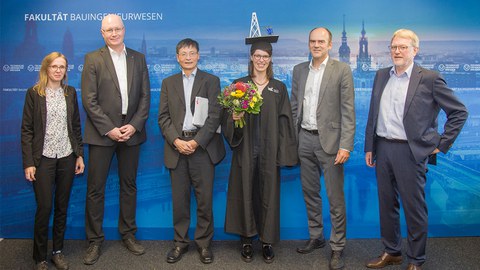Sep 24, 2024
Promotion Marina Stümpel

Maria Stümpel and the doctoral committee present
On 23.09.2024, Ms. Marina Stümpel, M.Sc. successfully defended her doctoral thesis on the topic "Cast nodes as fasteners for modular prefabricated truss structures made of high-performance concrete". In addition to the chairman of the doctoral committee, Prof. Dr. Michael Kaliske (TUD Dresden University of Technology), Prof. Dr. Steffen Marx (TUD Dresden University of Technology), Prof. Dr. Nguyen Viet Tue (Graz University of Technology) and Prof. Dr. Stefan Löhnert (TUD Dresden University of Technology) were present as reviewers. Prof. Dr. Yvonne Ciupack (TU Dresden) was also present as a member of the doctoral committee.
Abstract:
Climate change and the increasing scarcity of resources are facing the construction industry with challenges that have already led to a rethinking. In recent years, extensive research has been carried out in the field of high-performance materials and new structural concepts that provide solutions for sustainable construction. The studies show that the key to sustainable construction lies in the combination of different building materials and the use of prefabricated elements.
With this in mind, a latticed modular structure consisting of prefabricated ultra-high performance reinforced concrete pipes and thin-walled cast iron nodes was investigated. The connection between the cast iron nodes and the ultra-high performance reinforced concrete pipes is designed as a grouted connection and forms the basis for this work. With the aim of transferring the multi-axial loads in line with the force flow with a low material input, the investigations are focussed on the development of a suitable surface profiling of the cast iron nodes, the force transmission between the material components, and the derivation of load-bearing mechanisms for the new type of connection.
In order to experimentally analyse the load-bearing behaviour of the new type of connection, a test concept was developed to examine the connection under the relevant loads. In compression and tensile tests on plate-like test specimens, it was shown that the load-bearing behaviour of the connection is influenced by the surface profiling and the radial stiffness of the cast iron nodes as well as the type of load. In large-scale bending tests, on the other hand, the load-bearing behavior of the connection was investigated more realistically by varying the number of shear keys and the grouting length.
In addition to the experimental investigations, numerical analyses were carried out which made it possible to analyse the stress states prevailing in the connection. For this purpose, the numerical models were first calibrated using the results of the experimental investigations. Based on the non-linear material behaviour of the grout concrete and the contact interaction between the components, the numerical models are able to reproduce the load-bearing behaviour of the test specimens from the experimental investigations. The numerical models thus provide important insights into the load-bearing mechanisms in the connection, which can be used for future design approaches.
The investigations confirm the fundamental functionality of the proposed design principle
and form an important basis for further research work. Overall, cast iron nodes as connecting elements for modular prefabricated truss constructions made of high-performance concrete offer the potential for high-performance constructions which meet the requirements of sustainable construction.
We would like to congratulate Ms. Marina Stümpel on completing her doctorate and wish her all the best and every success for the future.
